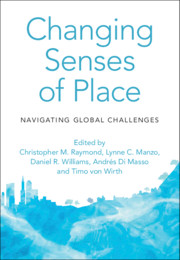Book contents
- Changing Senses of Place
- Changing Senses of Place
- Copyright page
- Dedication
- Contents
- Contributors
- Foreword
- Preface
- Acknowledgements
- Introduction
- Part I Climate Change and Ecological Regime Shifts
- Part II Migration, Mobility and Belonging
- Part III Renewable Energy Transitions
- 10 Farming Landscapes, Energy Landscapes or Both?
- 11 Auto-Photography, Senses of Place and Public Support for Marine Renewable Energy
- 12 A Life Course Approach to the Pluralisation of Sense of Place
- Part IV Nationalism and Competing Territorial Claims
- Part V Urban Change
- Part VI Technological and Legal Transformations
- Part VII Design and Planning Strategies for Changing Senses of Place
- Part VIII Conclusion
- Index
- References
11 - Auto-Photography, Senses of Place and Public Support for Marine Renewable Energy
from Part III - Renewable Energy Transitions
Published online by Cambridge University Press: 15 July 2021
- Changing Senses of Place
- Changing Senses of Place
- Copyright page
- Dedication
- Contents
- Contributors
- Foreword
- Preface
- Acknowledgements
- Introduction
- Part I Climate Change and Ecological Regime Shifts
- Part II Migration, Mobility and Belonging
- Part III Renewable Energy Transitions
- 10 Farming Landscapes, Energy Landscapes or Both?
- 11 Auto-Photography, Senses of Place and Public Support for Marine Renewable Energy
- 12 A Life Course Approach to the Pluralisation of Sense of Place
- Part IV Nationalism and Competing Territorial Claims
- Part V Urban Change
- Part VI Technological and Legal Transformations
- Part VII Design and Planning Strategies for Changing Senses of Place
- Part VIII Conclusion
- Index
- References
Summary
Many countries are considering the deployment of renewable energy technologies in marine or coastal locations to mitigate climate change. Here, we consider ways that senses of place have implications for the deployment of offshore wind, tide and wave energy projects. We use in-depth interviews with auto-photography to explore multiple senses of places in an island context with the aim of gauging public views about the acceptability of potential deployment of wind, tidal and wave energy technologies. The study captured many instances where senses of place were invoked to construct arguments around the fit (or lack of) between place and technology, with place used flexibly to refer to specific marine or coastal locations, the island itself and its relation to other places. Auto-photography revealed the diversity of ways in which the land and the sea were meaningful to islanders – as a place for social relations, a place for fun and sport, a place for escape and a place for aesthetic beauty. By combining visual and verbal data to reveal multiple senses and scales of place, the study provides a rich foundation for understanding the acceptability of renewable energy projects.
Keywords
- Type
- Chapter
- Information
- Changing Senses of PlaceNavigating Global Challenges, pp. 144 - 155Publisher: Cambridge University PressPrint publication year: 2021
References
- 1
- Cited by



